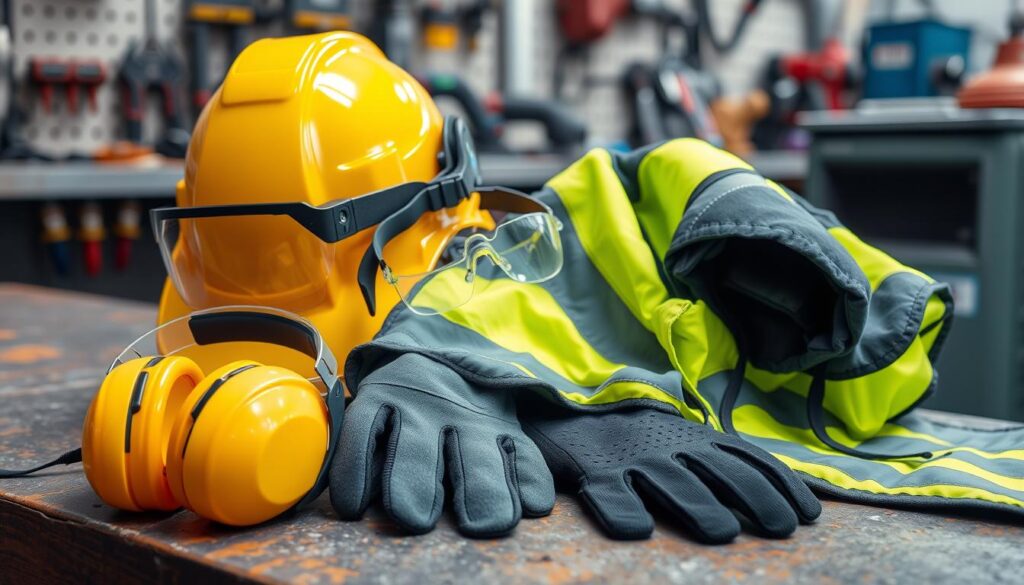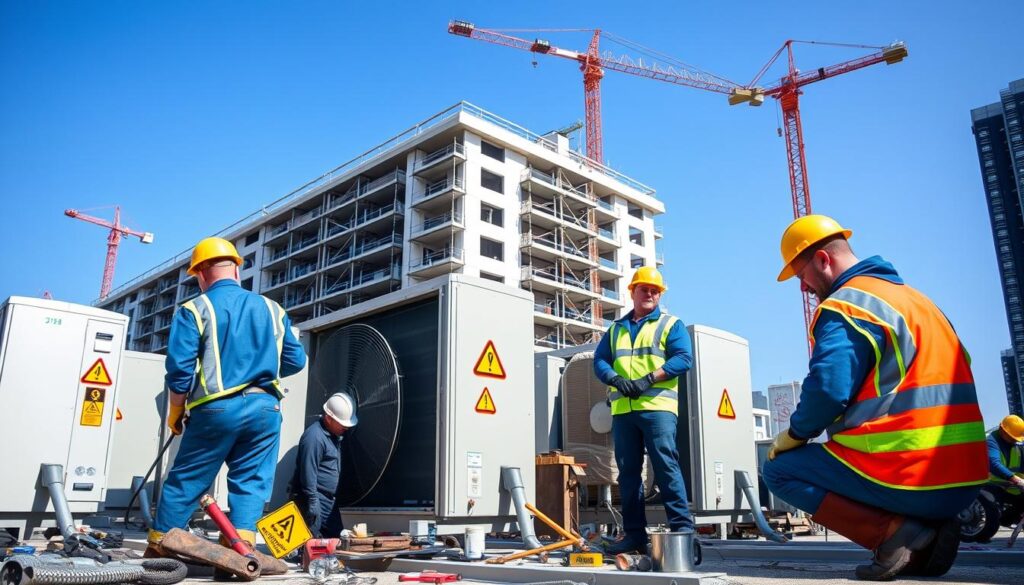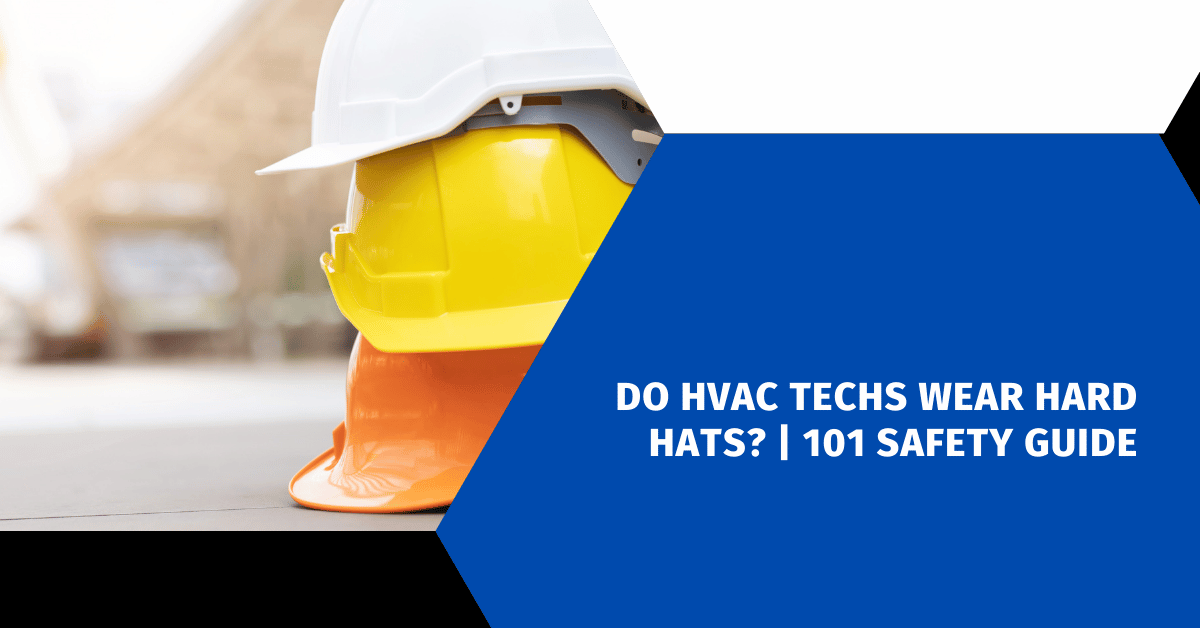Affiliate Disclosure
HVAC Guide Guys is a participant in the Amazon Services LLC Associates Program, an affiliate advertising program designed to provide a means for sites to earn advertising fees by advertising and linking to Amazon.
Do HVAC Techs Wear Hard Hats? Every year, over 100 people in the U.S. die from falls off ladders. Thousands more get hurt. As an HVAC technician, your safety is key. Wearing the right protective gear is essential.
This guide will cover the safety needs, personal protective equipment (PPE), and industry rules for HVAC workers. We’ll focus on the use of hard hats in different work places.

Key Takeaways
- HVAC technicians face many safety risks, like chemicals, bacteria, molds, and extreme temperatures.
- OSHA says PPE, including hard hats, must be used in certain work areas to protect HVAC workers.
- Choosing and keeping hard hats in good shape is vital for worker safety and following industry rules.
- Wearing company uniforms can make you look professional. It can also make a good impression on clients.
- Having good safety plans and knowing how to respond in emergencies is key to keeping HVAC workers safe.
Table of Contents
Understanding HVAC Technician Safety Requirements
HVAC technicians must follow strict safety rules set by OSHA and industry standards. These rules help keep them and their customers safe. They cover dangers like chemical exposure, electrical risks, and working at heights.
Basic Safety Standards for HVAC Work
At the heart of HVAC safety are basic rules all technicians must follow. They wear HVAC worker head protection like goggles and hard hats. They also use other PPE, like steel-toed boots and gloves.
They must handle electrical parts carefully and work safely with hazardous materials. They also need to be careful when working in tight spaces or at heights.
OSHA Requirements for HVAC Professionals
OSHA is key in setting and enforcing HVAC safety rules. Their standards cover many areas, like electrical safety and fall protection. HVAC workers need to be well-trained and equipped to follow these rules.
Industry Safety Regulations
The HVAC industry also has its own safety rules and best practices. These can change based on the work setting, like construction sites or homes. Technicians must keep up with these guidelines to stay safe and protect others.
| Safety Hazard | Protective Measures |
|---|---|
| Exposure to chemicals and bacteria | Proper PPE, including face masks and gloves |
| Electrical system hazards | Training in electrical safety and use of insulated tools |
| Working at heights | Fall protection equipment, such as harnesses and guardrails |
| Extreme weather conditions | Appropriate clothing and weather-resistant gear |
By following these safety rules, HVAC technicians can keep themselves and their customers safe. They can do their job well and with care.
Explore Our HVAC Shop
Looking for top-rated HVAC tools, parts, and accessories? Visit our shop and find the perfect solution for your needs.
Visit the ShopDo HVAC Techs Wear Hard Hats?
Is it necessary for HVAC technicians to wear hard hats? The answer depends on their work environment and the dangers they might face.
HVAC workers are told to always wear hard hats in dangerous places. This is especially true on construction sites or in industrial areas. The MSA 475407 Skullgard hard hat is a top pick for workers in risky jobs like welding and oil and gas.
Some hard hats are better for extreme temperatures. The Fiber-Metal P1 hard hat is safe in very hot or cold conditions. The MSA 454666 Skullgard protective hard hat can handle up to 350°F and electrical shocks of up to 2200 volts.
Hard hats are not always required for HVAC technicians. But they are key to preventing serious head injuries. The Pyramex full brim hard hat meets safety standards and is light, making it a favorite among HVAC workers. The Pyramex Ridgeline full brim hard hat also offers great protection and a custom fit.
Whether to wear a hard hat depends on OSHA rules or site-specific safety checks. HVAC technicians should always choose safety first. They should make sure their hard hats are in good shape and consider upgrades for a better fit.
Explore Our HVAC Shop
Looking for top-rated HVAC tools, parts, and accessories? Visit our shop and find the perfect solution for your needs.
Visit the ShopEssential Personal Protective Equipment (PPE) for HVAC Workers
As an HVAC technician, your safety is key. The right personal protective equipment (PPE) is vital to keep you safe. From head to toe, you need specialized gear to protect you from dangers.
Head and Face Protection
Keeping your head and face safe is a top priority. HVAC workers might wear hard hats to protect against falling objects. Safety glasses or face shields protect your eyes from debris and chemicals.
Respirators with HEPA filters or N95 face masks are also crucial. They help keep your respiratory system safe from harmful fumes and particles.
Body Protection Gear
Flame-resistant clothing is essential for HVAC technicians. It protects you from electrical hazards and extreme temperatures. Insulated gloves shield your hands from burns, cuts, and harsh chemicals.
Steel-toed boots with slip-resistant soles prevent foot injuries. They are important when working with heavy equipment or sharp tools.
Hand and Foot Safety Equipment
Your hands and feet are at risk of injury. Insulated gloves protect against electrical shocks, cuts, and abrasions. Steel-toed boots are vital for protection against falling objects and sharp tools.
Using essential HVAC safety gear greatly reduces job risks. It ensures your safety and well-being. Investing in quality PPE is worth it for the peace of mind and protection it offers.
“At Donnelly Mechanical, the safety protocols and procedures are designed to not only meet but exceed industry standards.”
Common Workplace Hazards in HVAC Industry
HVAC technicians face many workplace hazards. They need to follow strict safety rules. These include electrical risks, chemical exposure, respiratory issues, and fall dangers.
In 2020, the top five accidents in HVAC were sprains, strains, and tears; cuts and lacerations; fractures; bruises and contusions; and heat or chemical burns. These numbers highlight the need for strong HVAC job site safety and employee safety protocols.
Some common hazards in HVAC include:
- Electrical Hazards: Risk of electrical shocks, burns, or fires if safety precautions aren’t followed.
- Exposure to Harmful Substances: Working with chemicals, refrigerants, and gases can cause harm if mishandled.
- Working at Heights: Working at heights can result in severe injuries if falls occur.
- Equipment Safety: Improper use of equipment can lead to accidents.
To lower these risks, HVAC workers must follow industry rules and safety standards. Organizations like OSHA, EPA, and NFPA set these guidelines. Tools like ISNetworld® help check if safety rules are followed.
By focusing on HVAC job site safety and employee safety, technicians can make their work safer. This reduces the chance of accidents and injuries.

Explore Our HVAC Shop
Looking for top-rated HVAC tools, parts, and accessories? Visit our shop and find the perfect solution for your needs.
Visit the ShopHard Hat Requirements in Different Work Settings
Hard hats are needed in various HVAC work settings. It’s important to know the rules for each place. This keeps HVAC workers safe and follows the law.
Construction Sites and Industrial Facilities
Hard hats are a must on construction sites and in industrial places. This is because of the danger of falling objects and head injuries. In 2022, 64% of highway contractors faced crashes into their work areas.
OSHA and the ANSI/ISEA Z89.1-2014 standard set the rules for hard hats. They must protect against falling objects, deflect blows, and absorb shock.
Commercial Buildings
In commercial buildings, the need for hard hats depends on the work area and hazards. HVAC workers in areas with overhead tools might need hard hats. But, those in open spaces might not.
Some employers make everyone wear hard hats, even if OSHA doesn’t require it. This is to add extra safety.
Residential Properties
Hard hats are not always needed in homes, but they’re suggested in risky areas. This includes attics and crawl spaces. Even though the risk is lower, it’s still wise for HVAC workers to wear them.
Every HVAC worker should know the latest safety rules. They should also use the right protective gear. This way, they can stay safe and work well together.
Professional Appearance and Safety Standards
Being an HVAC technician means looking the part as much as following safety rules. Your clothes and tools show you care about quality and safety. They also make a good first impression on clients.
Wearing clean, well-kept uniforms or work clothes is key. Branded uniforms with your company’s logo build trust and show you’re part of the team. Using HVAC technician helmets and other PPE boosts your look and keeps you safe.
- Choose breathable, moisture-wicking shirts for comfort and function.
- Go for durable, water-resistant jackets to keep you dry in bad weather.
- Work pants with knee pads and tool pockets are great for moving around and staying safe.
- Wear safety boots with hard toes and slip-resistant soles to protect your feet.
- Use gloves that resist cuts, heat, and chemicals to keep your hands safe.
Looking professional and following HVAC contractor safety standards shows you’re serious about your work. It makes clients trust you more. A neat, safety-aware technician is more likely to get recommended, helping your career and the HVAC field.
“First impressions are crucial, with clients forming opinions within seconds, emphasizing the importance for HVAC technicians to maintain a professional appearance through neat and clean uniforms or technician attire.”
Proper Hard Hat Selection and Maintenance
Keeping the heads of HVAC workers safe is very important. Choosing the right HVAC worker head protection is key. It should protect against impacts, electrical shocks, and be comfortable to wear. HVAC techs need hard hats that meet their job’s safety standards.
Types of Hard Hats for HVAC Work
HVAC workers need hard hats that protect from all sides. Class E hard hats are great because they shield against head impacts and up to 20,000 volts of electricity. Class G hard hats also protect against impacts and up to 2,200 volts. For jobs without electrical risks, Class C hard hats are good for head impact protection.
Care and Inspection Guidelines
It’s important to take good care of protective headwear for HVAC workers. Hard hats should be replaced every 5 years, and suspensions every year. Clean them with mild soap and water and check for damage. If a hard hat is damaged, replace it right away to stay safe.
By picking the right hard hat and following care tips, HVAC techs can keep their HVAC worker head protection in top shape. This ensures they stay safe on the job.
Explore Our HVAC Shop
Looking for top-rated HVAC tools, parts, and accessories? Visit our shop and find the perfect solution for your needs.
Visit the ShopAdditional Safety Gear and Equipment
As an HVAC technician, your safety is key. You need more than just hard hats. You also need hearing protection like earplugs or earmuffs to protect against loud noises.
Keeping your tools and materials organized is also vital. Tool belts and pouches help you stay safe by keeping everything within reach. Safety harnesses and fall protection gear are must-haves when working at heights to avoid serious injuries.
It’s important to store and maintain your HVAC safety gear properly. This makes sure it works well and keeps you safe all day.
Specialized Safety Gear for HVAC Techs
- Hearing protection (earplugs, earmuffs)
- Tool belts and pouches
- Safety harnesses and fall protection
- Rubber mats for electrical work
- Flame-resistant clothing and gloves
- Face shields and respirators
It’s a challenge to look professional while following HVAC employee safety protocols. HVAC companies have rules about safety gear and uniforms. Following these rules keeps you safe and helps the company look good to customers.

“Safety should always be the top priority for HVAC technicians. Proper protective equipment and well-maintained gear can mean the difference between a routine job and a serious accident.”
As an HVAC pro, your focus on safety is important for the whole industry. Using the right HVAC safety gear and following HVAC employee safety protocols keeps you safe. It also encourages others to do the same.
Best Practices for HVAC Workplace Safety
Keeping the work area safe is key for HVAC workers. By setting up strong safety rules and steps, HVAC teams can keep their workers safe. They also make sure they follow industry rules. This means doing safety training often, checking for hazards, and talking clearly with the team.
Safety Protocols and Procedures
HVAC techs must follow strict safety rules to avoid risks. They wear the right safety gear like masks, face shields, gloves, and sturdy boots. They also use the right tools and equipment for each job, keeping everything in good shape to avoid accidents.
It’s important for HVAC workers to get regular safety training. This keeps them updated on the latest safety rules and practices. Employers should teach them about chemical safety, electrical dangers, and how to lift safely. This helps create a safe and responsible work culture.
Emergency Response Guidelines
Having clear emergency plans is vital for HVAC workplaces. These plans should cover different emergencies like electrical issues, chemical spills, and falls. HVAC techs need to know what to do in these situations and have the right safety gear, like fire extinguishers and first aid kits.
Using safety checklists and software can help follow safety rules better. By following these best practices, HVAC companies can keep their workers safe and meet safety standards.
“Safety should be the top priority in any HVAC workplace. By investing in comprehensive safety protocols and emergency response planning, we can protect our employees and maintain the highest standards of professionalism.” – John Doe, Safety Manager at ABC HVAC
Explore Our HVAC Shop
Looking for top-rated HVAC tools, parts, and accessories? Visit our shop and find the perfect solution for your needs.
Visit the ShopLegal Requirements and Compliance
As HVAC professionals, it’s key to know and follow the legal rules and safety standards. This means sticking to OSHA rules, state and local codes, and specific HVAC standards.
Being compliant means keeping records, doing safety checks, and training your HVAC employees well. Not following these rules can lead to big fines, legal trouble, and harm to your business’s image.
HVAC Construction Site Regulations
On HVAC construction sites, technicians must follow strict safety rules. They need to wear PPE like hard hats and safety glasses. They also have to handle dangerous materials and tools safely.
HVAC Employee Safety Protocols
HVAC companies must focus on keeping their employees safe. This means regular safety training, keeping equipment in good shape, and having emergency plans. By putting employee safety first, HVAC businesses can lower accident risks and keep their team safe.
| Regulation | Requirement | Penalty for Non-Compliance |
|---|---|---|
| OSHA | Mandatory use of PPE, proper handling of hazardous materials, and regular safety inspections | Fines up to $14,502 per violation |
| State and Local Safety Codes | Adherence to building codes, electrical safety standards, and environmental regulations | Fines, project delays, and potential license revocation |
| Industry-Specific Standards | Compliance with HVAC-related certifications, training, and best practices | Reputational damage and loss of competitive edge |
By focusing on legal rules and safety, HVAC companies can keep their team safe. They can also keep a good name and grow their business.
Conclusion
The use of HVAC safety gear, like hard hats, is key for HVAC techs. It protects them in different work places. The right HVAC worker head protection depends on the job site. But, always putting safety first is important for all HVAC pros.
By focusing on safety, being professional, and working efficiently, HVAC techs can make their work safer. They also provide top-notch services to their clients. Getting HVAC technician helmets and other safety gear is important. Also, going to safety training and seminars helps them stay updated.
A strong safety culture in the HVAC industry is vital. It needs support from employers and commitment from technicians. This ensures the safety of workers and the success of HVAC projects in homes, businesses, and factories.

